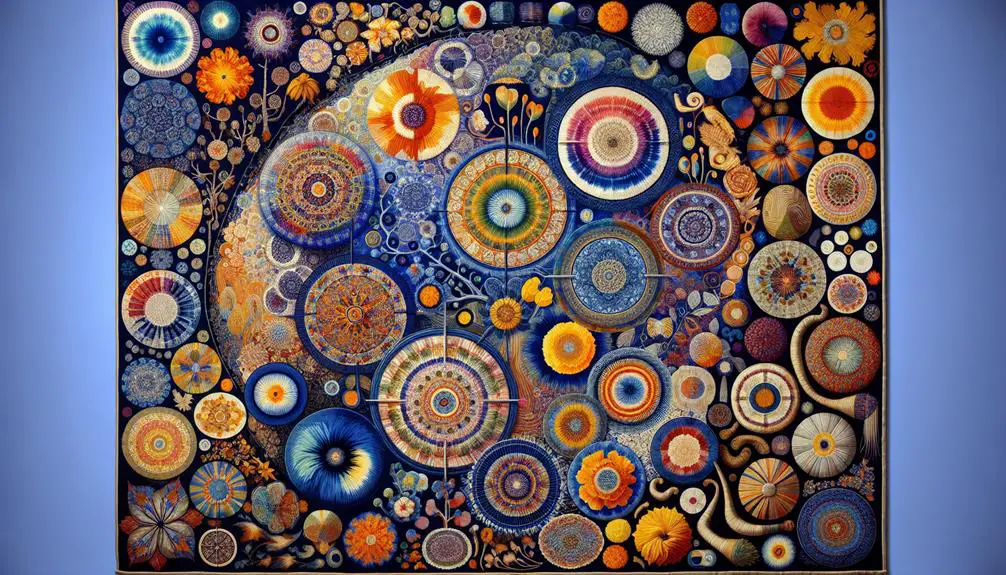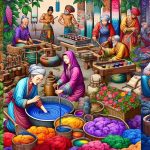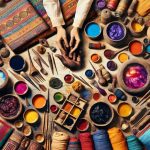Did you know that the earliest evidence of fabric dyeing dates back over 4,000 years to ancient Egypt? You've likely worn dyed fabrics countless times, but the history behind those colors is rich and complex. From the natural pigments of ancient civilizations to the intricate techniques of the Renaissance, each era has left its mark on fabric dyeing. Modern advancements now focus on sustainability, but how did we get here? Join us as we explore the fascinating evolution of dyeing methods, uncovering the innovations and cultural significance that shaped this colorful journey.
Table of Contents
Key Takeaways
- Ancient civilizations used natural dyes from plants, minerals, and insects with intricate, labor-intensive processes.
- Asian innovations included unique methods like indigo dyeing, Batik art, and Shibori, focusing on opulent and detailed designs.
- The Industrial Revolution introduced synthetic dyes and automated machines, enabling mass production and a broader color spectrum.
- The 20th century saw the transition from natural to synthetic dyes, ensuring consistent quality and color standardization.
- Modern dyeing practices emphasize eco-friendly methods, such as plant-based dyes and waterless techniques, to reduce environmental impact.
Ancient Egyptian Dyes
Ancient Egyptian dyes, crafted from natural sources, played a pivotal role in their vibrant textile traditions. You'll find their mastery of natural pigments nothing short of remarkable, as they used plants, minerals, and insects to create a palette that stood the test of time.
The Egyptians' intricate dyeing process guaranteed their fabrics weren't just colorful but also long-lasting, reflecting their sophisticated understanding of chemistry and art. To achieve rich hues, they often used indigo from woad plants for deep blues and madder root for stunning reds. Yellow came from safflower, while green was derived by overdyeing yellow with blue.
Each dyeing process started with preparing the fabric, usually linen, by thoroughly cleaning it to remove any impurities. Next, they'd soak the fabric in a mordant solution, often made from alum, to help the natural pigments bind effectively. Then came the actual dyeing. You'd submerge the fabric in a dye bath, carefully maintaining the right temperature and stirring consistently.
This meticulous attention guaranteed uniform color distribution. Finally, the fabric was thoroughly rinsed and dried, ready to be transformed into garments that showcased their rich cultural heritage.
Medieval European Methods
During medieval times, European artisans developed their own distinct dyeing techniques that reflected the era's unique cultural and economic influences. By mastering the use of natural pigments, they created vibrant, enduring colors that adorned the clothing and tapestries of nobility and common folk alike.
You'd find that woad, madder, and weld were among the most popular dyes, each derived from plants carefully cultivated or foraged.
To achieve the desired hues, medieval recipes were meticulously followed, often passed down through generations. You'd mix natural pigments with mordants like alum or iron to fix the colors onto fabric, making certain they didn't fade or wash away.
The dyeing process itself was labor-intensive, requiring precise timing and temperature control. Artisans would boil the dye baths in large cauldrons, stirring the fabric continuously to guarantee even color distribution.
As you explore further into these medieval methods, you'll appreciate the ingenuity and resourcefulness of European dyers. They not only produced stunning textiles but also laid the groundwork for modern dyeing techniques.
Asian Dyeing Innovations
You'll find that Asian dyeing innovations bring unique techniques to the table, including the intricate indigo dyeing methods.
Traditional Batik art also stands out with its wax-resist dyeing process, creating stunning patterns.
Let's explore how these ancient practices continue to influence modern fabric dyeing.
Indigo Dyeing Methods
Indigo dyeing methods in Asia showcase a rich tapestry of innovation and tradition that have been perfected over centuries. You'll find that natural dyeing with indigo isn't just about achieving a vibrant blue hue; it's about embracing a holistic process that respects the environment and honors cultural heritage.
One standout technique is shibori, a Japanese art that involves intricate folding, twisting, and binding of fabric before dyeing. This method creates stunning, one-of-a-kind patterns that can be simple or complex, depending on your skill level and creativity.
In India, the indigo dyeing process also reflects a deep-rooted connection to nature. The dye is derived from the indigo plant, which is meticulously cultivated and harvested. You start by fermenting the leaves to extract the dye, a technique that has been handed down through generations.
The fabric is then repeatedly dipped in the indigo vat, oxidizing between each dip to achieve the desired depth of color. This method safeguards that the fabric retains its vibrant hue and durability.
Traditional Batik Art
In the world of Asian dyeing innovations, traditional batik art stands out for its intricate wax-resist technique that produces mesmerizing patterns and vivid colors. This method, originating from Indonesia, involves applying wax to fabric in specific designs. When you dye the fabric, the wax resists the dye, preserving the original color of the cloth beneath. This process can be repeated with multiple colors and layers, creating a rich tapestry of intricate patterns.
Imagine holding a piece of cloth, and with each brushstroke of wax, you're not just designing but storytelling. The magic lies in the details—every swirl and dot contributes to the grand narrative of the fabric.
| Step | Description | Outcome |
|---|---|---|
| Wax Application | Apply hot wax using a canting or stamp | Wax-resist areas on fabric |
| Dyeing | Submerge fabric in dye | Dye colors non-waxed areas |
| Wax Removal | Boil or scrape off the wax | Reveals intricate patterns underneath |
Mastering batik requires patience and precision. You'll find that the more you practice, the more control you gain over the wax resist application, resulting in finer, more intricate patterns. Each piece you create becomes a testimony to your growing expertise and appreciation for this timeless art form.
Renaissance Fabric Art
During the Renaissance, fabric art thrived with intricate dyeing techniques that reflected the era's opulence and creativity. You could see this mastery in the stunning renaissance tapestries that adorned the grand halls of nobility. These tapestries weren't just decorative; they were storytelling masterpieces woven with exceptional textile craftsmanship. Dyeing techniques like mordant dyeing and resist dyeing were essential to achieve the rich, vibrant colors that made these pieces so enchanting.
As you explore further into Renaissance fabric art, you'll appreciate the meticulous attention to detail. Artisans used natural dyes derived from plants, insects, and minerals. They blended these elements to create an array of hues, from the deep indigos of woad to the bright reds of madder root. The process didn't stop at dyeing; finishing techniques like embroidering with gold and silver threads added layers of luxury and complexity.
You'll notice that fabric art during this time wasn't just about beauty; it was a display of power and status. Owning richly dyed textiles signified wealth and sophistication. Mastering these techniques required not only skill but also an understanding of chemistry and artistry, making Renaissance fabric art a pinnacle of textile craftsmanship.
Industrial Revolution Changes
As the Industrial Revolution took hold, the fabric dyeing techniques that had flourished during the Renaissance underwent significant transformations, driven by technological advancements and the demands of mass production. You'll find that the era's rapid technological progress redefined the entire landscape of fabric dyeing.
Textile factories began to emerge, equipped with machinery that could process large quantities of fabric more efficiently than ever before. No longer limited to small-scale operations, dyeing became an integral part of the burgeoning textile industry. These factories utilized steam power and advanced mechanical looms, speeding up production and ensuring consistent dye application.
The invention of synthetic dyes in the mid-19th century further revolutionized the industry, providing an array of vibrant, long-lasting colors that were previously unattainable with natural dyes. You can appreciate the significance of these changes, as they not only increased the availability of dyed fabrics but also lowered costs, making colored textiles accessible to a broader audience.
The shift to mass production transformed dyeing from an artisanal craft into a key industrial process, laying the groundwork for modern textile manufacturing. This period marked a pivotal moment in the evolution of fabric dyeing techniques, driven by the relentless pace of industrial innovation.
20th Century Techniques
The 20th century witnessed fabric dyeing techniques evolve with innovations like automated dyeing machines and the development of advanced synthetic dyes. You'll notice how these advancements built upon 19th century innovations and enhanced textile technology. These improvements allowed for more precise and consistent coloration, making it simpler to achieve vibrant hues and intricate patterns.
Victorian dyeing trends had a historical significance that continued to influence 20th-century practices. For example, the fascination with rich, deep colors, and intricate designs persisted, but with greater efficiency and less labor-intensive methods. The transition from natural to synthetic dyes also marked a significant departure from the past, offering a broader spectrum of colors and increased colorfastness.
Here are some key developments:
- Automated Dyeing Machines: Revolutionized the industry by reducing manual labor and enhancing production speed.
- Synthetic Dyes: Provided a wider range of colors and improved colorfastness over natural dyes.
- Standardization: Ensuring consistent quality and color across large batches of fabric.
- Innovative Textile Technology: Enhanced the dyeing process with better control and precision.
- Historical Significance: Continued to draw inspiration from Victorian dyeing trends, blending tradition with modern techniques.
Modern Sustainable Practices
In recent years, sustainable fabric dyeing practices have gained momentum, focusing on reducing environmental impact and improving resource efficiency. You've likely noticed a shift towards eco-friendly alternatives and ethical sourcing in the textile industry. Modern techniques emphasize using natural dyes, waterless dyeing methods, and closed-loop systems to minimize waste.
Eco-friendly alternatives like plant-based dyes reduce the reliance on synthetic chemicals. These dyes come from renewable sources and often produce less harmful waste. Waterless dyeing methods, such as supercritical CO2 dyeing, eliminate the need for large volumes of water, which is essential in areas facing water scarcity. Closed-loop systems guarantee that any waste generated is reused or recycled, promoting a circular economy.
Here's a quick comparison to help you grasp the benefits:
| Technique | Benefits |
|---|---|
| Plant-based dyes | Renewable source, less chemical waste |
| Supercritical CO2 dyeing | Water conservation, reduced wastewater |
| Closed-loop systems | Waste minimization, resource efficiency |
| Ethical sourcing | Fair labor practices, sustainable harvesting |
Frequently Asked Questions
How Do Natural Dyes Compare to Synthetic Dyes in Terms of Colorfastness?
Natural dyes offer rich color vibrancy and environmental sustainability, but they often lack longevity. In contrast, synthetic dyes provide excellent colorfastness and longevity, yet they pose significant environmental impact challenges. Choose wisely based on your priorities.
What Safety Precautions Should Be Taken When Dyeing Fabrics at Home?
When dyeing fabrics at home, maintain proper ventilation and wear protective gear. Use gloves for skin protection. Follow local guidelines for dye disposal to prevent environmental harm. Prioritize safety to achieve professional results.
Are There Any Health Risks Associated With Wearing Chemically Dyed Fabrics?
Yes, there are health implications associated with wearing chemically dyed fabrics. Chemical dyes in fabric dyeing can cause allergies and sensitivities. You might experience skin irritation or allergic reactions, especially if you have sensitive skin.
How Does Fabric Type Influence the Dyeing Process and Outcome?
Fiber compatibility and color vibrancy greatly shape the dyeing process. Different fabrics impact dye absorption and the final appearance. You'll notice natural fibers excel in even absorption, while synthetics might struggle with achieving vivid, vibrant hues.
Can Dyed Fabrics Be Recycled or Repurposed Effectively?
Yes, you can effectively recycle dyed fabrics. Repurposing fabric not only reduces waste but also offers creative opportunities. By recycling textiles, you contribute to a sustainable fashion industry while mastering innovative design techniques.
- How Does Ring Spun Cotton Affect Garment Fit and Shape Retention? - August 13, 2024
- What Are the Challenges in Producing Ring Spun Cotton? - August 13, 2024
- Is Ring Spun Cotton Suitable for Plus-Size Clothing? - August 13, 2024





